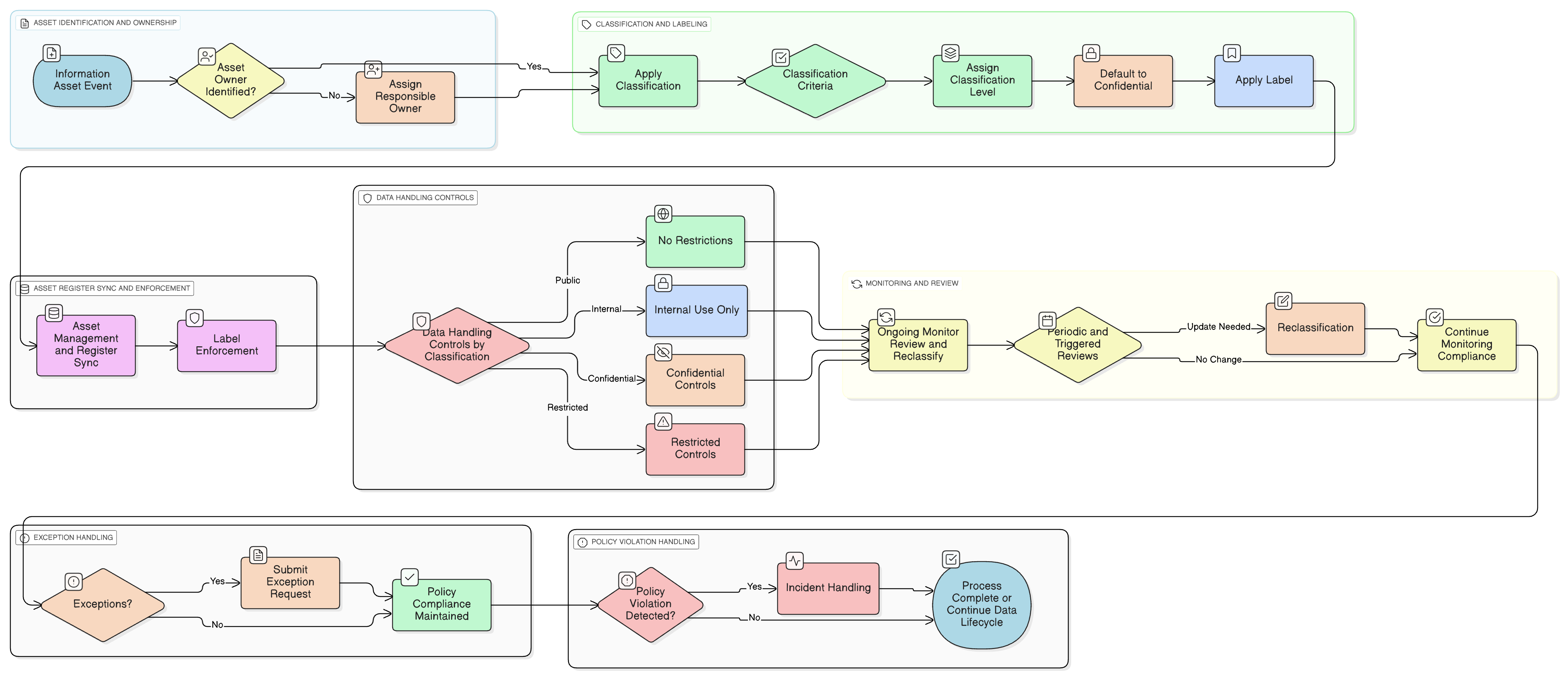Overview
This policy sets out a formal approach for classifying and labeling all information assets based on sensitivity, risk, and regulatory obligations, ensuring clear, persistent labeling and standardized protection practices across the organization.
Standardized Classification
Defines a clear, organization-wide schema for classifying and labeling data by sensitivity and risk.
Mandated Labeling
Enforces persistent labeling for all information assets, ensuring visibility and traceability.
Comprehensive Scope
Covers digital, physical, internal, third-party, and all data formats and environments.
Compliance Alignment
Supports adherence to ISO/IEC 27001, 27002, GDPR, NIS2, DORA, COBIT, and NIST standards.
Read Full Overview
Policy Diagram

Click diagram to view full size
What's Inside
Scope and Rules of Engagement
Role-Based Responsibilities
Classification Tiers & Criteria
Label Application & Enforcement
Exception & Risk Handling
Training and Review Requirements
Framework Compliance
🛡️ Supported Standards & Frameworks
This product is aligned with the following compliance frameworks, with detailed clause and control mappings.
Related Policies
Access Control Policy
Access to information is governed by classification levels; more sensitive data requires stricter access control and authorization mechanisms.
User Account And Privilege Management Policy
Reinforces privilege allocation based on need-to-know, which is informed by classification tiers.
Asset Management Policy
Ensures that each asset in the inventory includes its classification and label, supporting traceability and accountability.
Data Retention And Disposal Policy
Disposal and retention rules are determined by the classification level of data and regulatory retention mandates.
Cryptographic Controls Policy
Applies appropriate encryption standards based on the classification of the information asset.
Logging And Monitoring Policy
Enables monitoring of access to and movement of classified information, ensuring auditability and detection of mislabeling or misuse.
About Clarysec Policies - Data Classification and Labeling Policy
Effective security governance requires more than just words; it demands clarity, accountability, and a structure that scales with your organization. Generic templates often fail, creating ambiguity with long paragraphs and undefined roles. This policy is engineered to be the operational backbone of your security program. We assign responsibilities to the specific roles found in a modern enterprise, including the CISO, IT Security, and relevant committees, ensuring clear accountability. Every requirement is a uniquely numbered clause (e.g., 5.1.1, 5.1.2). This atomic structure makes the policy easy to implement, audit against specific controls, and safely customize without affecting document integrity, transforming it from a static document into a dynamic, actionable framework.
Role-Based Accountability
Responsibilities are precisely assigned to CISO, Info Owners, IT, and committees, ensuring traceable enforcement across teams.
Automated Enforcement Support
Integrated with DLP, SIEM, and access tools for automatic validation, reporting, and blocking of misclassified or unlabeled data.
Exception Handling Framework
Builds in formal request, risk assessment, compensating controls, and review process for managing policy exceptions securely.
Frequently Asked Questions
Built for Leaders, By Leaders
This policy was authored by a security leader with 25+ years of experience deploying and auditing ISMS frameworks for global enterprises. It's designed not just to be a document, but a defensible framework that stands up to auditor scrutiny.
